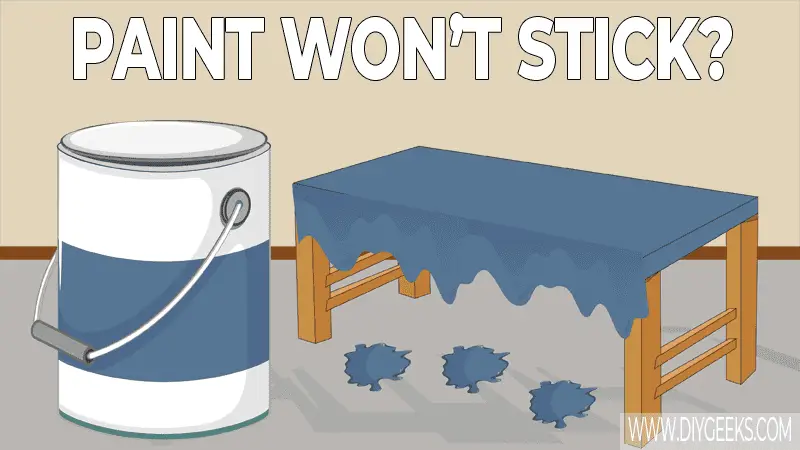Poor paint adhesion refers to a situation where the paint coating doesn’t adhere properly to a surface and is easily removed from it.
The reasons paint won’t stick include dirty surface, sealed surface, wet paint type, and wet surface.
To improve paint adhesion, use primer, remove the existing finish, and paint in the right conditions.
Why Won’t Paint Stick?
The reasons paint won’t stick are listed below.
1. Dirty Surface
Paint doesn’t stick over a dirty surface riddled with dirt, dust, debris, or stains. The dirt and dust form a loose barrier over the surface and prevent proper paint penetration and adhesion.
How To Fix It?
You must clean the surface with warm soapy water to remove dust and dirt before painting over it. If the surface has stubborn stains or sticky residue, use a scraper or solvent-based cleaner to remove them.
Ensure to properly dry the surface before painting over it.
2. Sealed Surface
A paint coating doesn’t adhere over a sealed surface because it can’t penetrate the surface pores. The existing sealer forms a moisture-resistant layer over the surface and prevents paint from penetrating and adhering to it.
Since paint can’t penetrate the sealer finish or surface pores, it won’t adhere and will peel off from the surface.
To know if a surface is sealed, do the following things.
- Inspect the Surface. If the surface finish is shiny or reflective, it’s sealed.
- Pour Water Over the Finish. The surface is sealed if the water can’t penetrate it and stays over the top layer. If the water penetrates the surface, it’s not sealed.
- Scrape the Finish. If you see glossy film on the scraper, the surface is sealed.
How To Fix It?
You must remove the sealer’s glossy top layer or remove the entire finish before applying the paint coating. To remove a sealer finish, use coarse-grit sandpaper (40-grit) or paint-stripping paste.
To remove the sealer’s glossy top layer, use medium-grit sandpaper (100-grit). The medium-grit sandpaper is abrasive enough to remove the top layer without removing the entire finish.
To remove the sealer finish, use coarse-grit sandpaper (40-grit) to gradually wear off the sealer coating until it’s removed.
The paint-stripping paste penetrates the sealer finish, breaks the bond between the binders, and softens or liquefies the coating. Simply apply the paint-stripping paste over the finish, wait around 20 minutes, and scrape the paint-stripping paste with a scraper and the sealer comes off too.
Tip: Clean the surface with warm soapy water to remove the dust created from sanding or the paint-stripping compound residue.
3. Wrong Paint Type
If you apply the wrong paint type over an existing finish, the paint won’t adhere. For instance, if you apply a water-based paint over an oil-based finish, the paint won’t adhere as paints aren’t compatible.
How To Fix It?
The only way to fix this is to use the right type of paint.
4. Wet Surface
Paint doesn’t adhere over a wet surface as the moisture prevents it from penetrating, adhering, or drying. The wood moisture levels must be lower than 12% for paint to adhere over it.
Moisture fills the surface pores, so paint can’t penetrate the pores and won’t adhere. Water-based paints are mostly affected by surface moisture as the high amount of moisture (or water) will over-thin the paint.
How To Fix It?
You must dry the surface before applying a paint coating. To do so, use a hairdryer, increase the air circulation, or expose the surface to sunlight.
If the surface is affected by a water leak, spills, or constant water exposure, you must find and fix the issue and prevent the surface from getting exposed to water before applying paint.
5. Low Temperature and High Humidity
Paint won’t adhere or dry properly if the ambient temperature is lower than 50°F (10°C) and the humidity levels are higher than 50%.
If the temperature is too low, the paint remains wet longer and can peel off from the surface without adhering.
6. Over-thinned Paint
If you over-thin paint before application, the paint won’t adhere to the surface and will peel off.
The thinning purpose it create a thinner paint viscosity and flow so it can penetrate small surface pores, but if you over-thin it the paint will be too thin to adhere.
Over-thinning paint will add more solvent (oil or water) to the formula compared to the additives, this creates an inconsistent paint flow that doesn’t dry or adhere.
How To Fix It?
If you add too much thinner to the paint, increase the paint amount in the mixture to thicken the viscosity.
If you applied an over-thinned paint to the surface, wipe the paint off and re-apply a new thicker coating.
How To Improve Paint Adhesion?
To improve paint adhesion, do the following things.
1. Use Primer
To improve the paint adhesion, apply a primer coating to the surface. The primer forms a textured layer over the surface that enhances paint penetration and adhesion.
However, you must use the right primer type. Use a water-based primer for water-based paints and an oil-based or enamel primer for oil-based paints. There are some oil-based primers, such as Zinsser shellac-based, that can also be used for latex (or water-based) paints.
2. Remove the Existing Finish
If the surface is already painted or sealed, the paint won’t adhere properly unless you remove the existing finish. While paint can adhere over another paint finish, the adhesion won’t be as good as if it were applied over a bare surface.
3. Paint in the Right Conditions
The best temperature range for painting is between 50°F-85°F (10°C-30°F). The best humidity levels for painting are lower than 50%.
5. Spray the Paint
Spraying the paint creates better adhesion because it’s applied at a higher pressure and speed which makes the surface absorb the paint better and faster.


